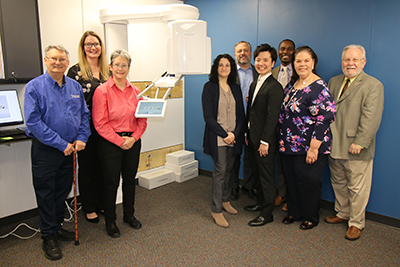Sherman becomes first Chiropractic College to install CBCT imaging
April 9, 2020True to its commitment to leading chiropractic education and improving patient care, Sherman College in Spartanburg, SC, has become the first chiropractic college to introduce cone beam computed tomography (CBCT) to its radiology department.
CBCT is a radiographic imaging method that allows accurate, three-dimensional imaging of hard tissue structures; its use and emergence in medical diagnostic imaging make CBCT an exciting addition to chiropractic radiographic analysis in the upper cervical region of the spine.

Drs. Christopher Kent, Jaime Browning, Pat Kuhta, Christine Theodossis, Joe Donofrio, Daiki Ishiyama, Ohmar Land, Laura Greene-Orndorff and Armand Rossi with the college’s new CBCT unit.
“Adding new technologies like cone beam computed tomography here at Sherman College further enhances our doctor of chiropractic program, improves patient care, and increases engagement and research opportunities within the profession and the community,” said Vice President for Academic Affairs Joe Donofrio, D.C., ’94, A.C.P.
“We are proud to be the first chiropractic college to incorporate this technology into our curriculum and our patient care. Our radiology and technique faculty played a key role in discovering and promoting this opportunity for the college,” Dr. Donofrio shared. “We expect that this unit will reveal details about cervical spine subluxations that we have likely never observed before.”
Sherman College began the process of bringing CBCT to campus in fall 2019 as part of its “I’m Ready” fundraising campaign, which focuses on securing resources to prepare the next generation of doctors of chiropractic for success. College partners in this effort include the Blair Chiropractic Society and the International Chiropractors Association’s (ICA) Council on Upper Cervical Care. Additional support for this and other technology enhancement projects is welcomed through the college’s I’m READY campaign.
“The Blair Upper Cervical Society and the ICA Council on Upper Cervical Care are excited about the opportunities we are creating together at Sherman College of Chiropractic,” said Tyler Evans, D.C., DCCJP. Dr. Evans serves on the Board of Directors of the ICA Council on Upper Cervical Care, as chair of its special committee on standards of practice, and a member of its committee on advanced imaging; he also serves on the Blair Upper Cervical Society’s special committee on cone beam CT.
“The craniocervical junction is one of the most complex joints in the body, both biomechanically and neurologically, and cone beam CT is revolutionizing the way in which upper cervical chiropractors correct that region of the spine,” Dr. Evans explained. “The research opportunities are endless, and we look forward to working with Sherman College to advance the upper cervical profession together.”
The Planmeca VisoTM CBCT unit was installed March 2 in the radiology department at Sherman College’s Chiropractic Health Center. This on-campus clinic provides approximately 30,000 patient visits each year to members of the Spartanburg and surrounding communities and serves as a teaching clinic for senior students in the doctor of chiropractic program.
The Planmeca VisoTM CBCT unit offers premium image quality and high-end usability. The unit is an impressive step forward in the evolution of cone beam imaging. Benefits of incorporating CBCT into patient care on Sherman College’s campus include the following, and more:
• Ability to acquire 3D images at significantly lower effective patient doses without a statistical reduction in image quality
• Live virtual field of view (FOV) positioning that can be adjusted freely
• Imaging that fits both orthogonal and articular needs
• Proper upright neutral patient positioning for upper cervical analysis
• Intelligent patient support that provides stability without compromising patient comfort
• Movement artifact correction for imaging patients who have difficultly remaining completely still.
Sherman College faculty and staff are completing training on how to take and analyze images using the Planmeca unit. When training is complete, faculty plan to utilize the new technology in patient care and collect evidence of its effectiveness in characterizing vertebral subluxations (misalignments of the spine that cause nerve interference) and advancing the efficacy of chiropractic care.
“We hope to work in cooperation with field practitioners and chiropractic organizations such as the Blair Chiropractic Society and the ICA’s Council on Upper Cervical Care to advance the use of technology in chiropractic care,” Dr. Donofrio shared. “We are ready to take our profession to the next level and to the rest of the world.”
Sherman College has been known for embracing emerging technology in chiropractic education; in 2007, it became the first chiropractic college on the East Coast to incorporate digital x-ray into its curriculum and Health Center services.













